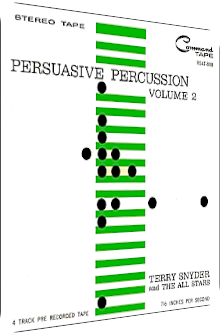
Terry Snyder
Persuasive Percussion Volume 2
1960
Percussionist and drummer Terry Snyder (1916–1963) does it a second time, and better so than ever before! Persuasive Percussion Volume 2 from 1960 is the, well, obvious follow-up of 1959's Persuasive Percussion. Both albums were released on Enoch Light's Command Records label, and Light watched the process of every recording session to make sure that the audiophile quality is guaranteed. Even though the addendum Volume 2 in its title causes a stale aftertaste in the mouths of listeners plagued by lackluster continuations of formerly inventive formulae, but Persuasive Percussion Volume 2 does not belong to that category, as the album is much better than its numeral and repetitive arc suggest.
Terry Snyder forms a nonet (= 9 musicians) with percussionists Willie Rodriguez, Teddy Sommer and Artie Marotti, legendary organist Dick Hyman who remains curiously under the radar on this release, accordionist Dominic Cortese whose talent shines all the brighter, double bassist Jack Lesberg, and guitarists Tony Mottola and Stanley Webb, so all previously featured musicians are gathered in the studio again. Twelve further renditions are presented, and while the title implies a focus on exotic percussion layers, the instrumentalists unleash many vividly crafted melodies of various Jazz classics and popular songs. Even flutes, vibes and marimbas are added in order to boost the exotic factor which is rounded off by bongos, congas, guiros, claves and castanets. Terry Snyder's renditions of these songs are top notch, some of them even tremendously imaginative; a kitschy opera excerpt is turned into a jumpy theme parisienne, and Oriental ditties are ennobled with Space-Age strings. I truly love Persuasive Percussion Volume 2, so I will take a closer look in the following paragraphs.
A rendition of Fred Fisher's Blue Is The Night opens the album. And sure enough is this a Command Records LP, as stereo-panned cymbals boost the liveliness of the composition and proudness of the lucky home stereo system owner. High-plasticity bongos, golden-shimmering pianos and marimba slivers mesh with a particularly brassy infusion. The jazzy segue in the middle of the song boosts the dreaminess with its vibraphone-piano couple after which a frantic drum segue leads to the final reoccurrence of the main motif. Though it is not overly exotic, Blue Is The Night is a spy theme opener with scents of tropical ingredients, especially percussion-wise, as expected. The nonet remains in blue territories with Leroy Anderson's and Mitchell Parish's Blue Tango, a twinkling, well, Tango with wonderful vibraphone reverberations and twinkles, Dominic Cortese's gleaming accordion, Tony Mottola's luminescent guitar twangs and tropical flute tones. Each of the instruments is firmly placed in the stereo channels, but the composition is too syrupy for me to enjoy it. At times, distant memories of Milt Raskin's only-ever Exotica stopover of 1959 called Kapu come to mind, but the aura is less enchanting.
The third track is a treat though, merging the metropolitan suburbs with the Tropics: Irving Fields' and Albert Gamse's Miami Beach Rhumba consists of a gorgeously uplifting guiro-fueled cowbell-interspersed bongo rhythm complete with slightly wonky marimba cascades, Latinized accordion stabs and pirate shanty-like saxophones. The atmosphere is comical, almost funny in its spectral setting, but still serious enough to make all links to Martin Denny's or Arthur Lyman's overly cartoon-like one-track examples on their 50's albums obsolete. Make no mistake, Miami Beach Rhumba is a standout track of Persuasive Percussion Volume 2 and a feast because of its music-related aesthetics, not its audiophile arc. Franz Lehar's opera excerpt Yours Is My Heart Alone loses all of its majesty as it is transformed into a faux-Parisian big band-oriented Exotica (!) piece. Bone-resembling marimbas, warped guitar licks and energetic show tune-oriented brass segments are tied together by a bongo aorta whose hollow decay conflates delicately with the tipsy jumpiness of the main melody. Say what you will, but Terry Snyder and his cohort make a big fuss about this clichéd tune, and rightfully so. Very crazy!
While the take on Albert William Ketèlbey's In A Persian Market surprises with its acidic six-note bass guitar motif, mysterious triangle-accentuated wind chimes, superbly aqueous piano chords, tambourin rhythms, Space-Age flutes and Dick Hyman's outlandish shawm-like organ preset next to the trumpet-heavy main melody, Pérez Prado's and Charlie Towne's vivid Mambo Jambo oscillates between African Jazz (even the African Jazz) and scents of Dixieland with its clapping rhythms, eupeptic upwards and downwards floating brass themes and wonderfully liquid marimba raindrops, finishing the great side A with an equally great bang.
Side B opens with Jerome Kern's and Johnny Mercer's Dearly Beloved, but despite its short interludes of twinkling glockenspiels and ringing triangles, the deep brass attacks outweigh the plinking iciness and make this a decidedly jazzy take of a potentially dreamy track. The eternal classic La Cucaracha is presented by the nonet in a swinging version, with only the cymbals, snake-like shakers, short solo sections and the resplendent drum interludes being particularly noteworthy. The following auspiciously titled Rock A Bongo Boogie is written by supervisors Enoch Light and Lew Davies themselves for this particular album. The bamboo rod base frame in tandem with the euphony of the accordions and marimbas plus the wave-like bass melody make this a mild spy theme at times, but as soon as the staccato nature of the melody sets in, it is more of a Saturday evening song. Tony Mottola's work on the guitar is noteworthy as well. He may be seldom featured, but once he is, he delivers an oxymoronic thermal heat of coolness.
Whereas Lady Of Spain, originally written by Toichard Evans and Erell Reaves, delivers the fastest tempo full of clicking castanets, accordion injections and sun-soaked Latin brass flourishes which oscillate between torero evocations and show tune settings, Edward Heyman's and John Waldo Green's Out Of Nowhere pushes the vibraphones back into the limelight and unites them with a hollow bongo groove, accordion sprinkles and a paradisiac alto flute melody. Reciprocating between Parisian fields and Lisbon memories, Out Of Nowhere also features a rhythmic shift that is ever so slightly more dreamy before the song ends in the same frantic manner, but with enigmatic vibraphone waterfalls of the exotic kind. Closing the album with Ary Barroso's Latin hymn Brazil which is presented here with clinging tambourins, grand brass bursts and a woodpecking marimba staccato, Terry Snyder's nonet leaves a damn fine impression.
Despite being the second entry of Persuasive Percussion which was supposedly created to cash in on the enormous success of volume one, Volume 2 is a remarkable album and, at least to my mind, the best volume out of four, even better than the first version. The material is varied, the band really up for a joyful session, and the sound quality top-notch. The melodies glimmer and twinkle, the percussion is indeed a very important stylistic element, and due to the large amount of vibraphone melodies and Tropical flutes, the Exotica factor is favorably high. Another surprising feature consists of the lack of doleful tones in minor. The band maintains the almost drugged state of beautiful colors and an uplifting atmosphere. Whether it is the sunscape of Miami Beach Rhumba, the fun-laden Oriental setting of In A Persian Market or the gargantuan transformation of Franz Lehar's kitschy evergreen Yours Is My Heart Alone, one hit comes after the other, and the interplay between fiery brass blasts and mystified vibraphone coves is always a joy.
Mentioning these facts is quite important to me, as there are albums on Command records which were created for audiophiles only. Here, however, the connoisseur of compositions – i.e. the music – is targeted as well. Even though the term Volume 2 may cause goosebumps and shivers, these doubts are not justified here, and I highly recommend this work to every Exotica fan, even those who did not find Persuasive Percussion Volume 1 to be particularly great. Terry Snyder and fellows have improved here. The only thing missing is the warm stadium organ sound Dick Hyman is known for, everything else is on board. Available on LP and in digital music stores. Recommended.
Exotica Review 184: Terry Snyder – Persuasive Percussion Volume 2 (1960). Originally published on Feb. 23, 2013 at AmbientExotica.com.
